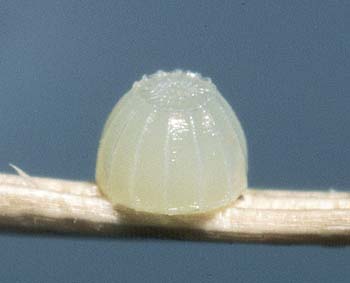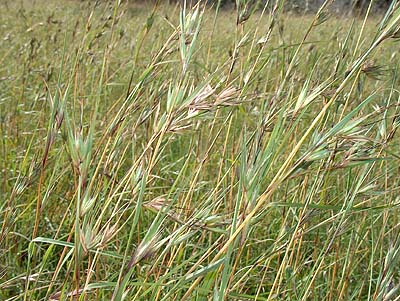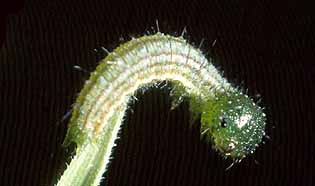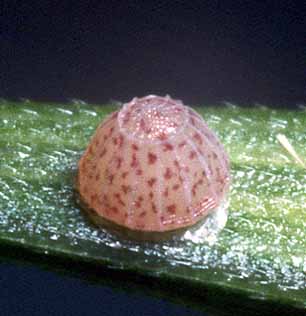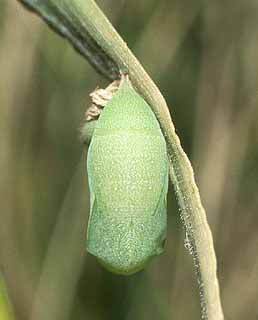-
Larval Food Host
-
Native and introduced grasses including Rytidosperma spp (wallaby grass),
Austrostipa flavescens (spear grass),
*Brachypodium distachyon (false brome),
*Ehrharta species including *E. calycina (perennial veldt grass),
*E. longiflora (annual veldt grass),
Poa spp incl.P. labillardieri (tussock grass),
P. morrisii, P. tenera (slender tussock grass),
Themeda triandra (kangaroo grass),
*Vulpia sp (fescue) (Poaceae).
Early instar larvae feed on the hostplant leaves. The larger, later instar larvae
will devour all the softer parts of the hostplant including young seed heads.
-
Eggs
-
Small, initially pale yellow or white, turbinate (expanding basally), the base
and apex are flat, moderately thick shelled, with well developed vertical ribs,
numbering 14-18. The top flattened area is also rimmed with a ridge, which is
beaded due the extensions of the vertical ridges. If the egg is fertile it
becomes purple speckled after a couple of days. In South Australia, the laid
eggs undergo a summer dormancy period, and larval development within the eggs
does not proceed until the eggs are either wetted by extended autumn rain, or
a certain reduced ambient temperature or decreased number of daylight hours
are reached (it has not been experimentally determined which is more important),
with some eggs remaining undeveloped until late June, some five months or more
after being laid. Even if the larva has developed within the egg, it will not
emerge until wetted by extended autumn rains. When ready to emerge, the larva
incompletely cuts out the top flattened area of the egg, leaving a small uncut
portion, and then pushes the top out like a trapdoor. The egg shell is then
usually eaten, giving the larva a nourishment boost, as some of the larvae can
be very weak. The larva then moves off to look for young grass shoots to eat.
While the females are still reasonably new, they tend to lay eggs with great
deliberation. They spend considerable time fluttering around grassy areas at
a height less than 1/2 m, frequently making quick aborted landings, but
eventually will stay on the ground and walk about, usually walking into a
vegetal debris laden area adjacent to some grass. There they will test several
sites and if to their liking, they will usually lay a single egg, but sometimes
two eggs are laid with the second egg laid on the first egg (to one side). The
eggs are always laid on dead vegetal material, usually part of the potential
hostplant. The dead vegetation provides good camouflage for the attached eggs.
Older females are not too fussy how they lay their eggs, and they will quickly
lay on any dead vegetal material near the hostplant, sometimes even on the bark
of tree trunks up to 1 m off the ground. Females often seem to prefer to lay eggs
in grassy areas that have browned off for summer.
-
Larvae
-
The first instar is pale grey with fine longitudinal brown lines, later becoming
greenish after eating the green leaves of the hostplant, and with numerous long
black hairs, knobbed at the tips. The head is dark brown above, yellow below,
with some long hairs, and there is some rugosity on an otherwise smooth surface.
The top of the head is rounded, without horns. The rear end is not forked in the
first instar. The second instar is similar to the first, but the head is green,
it acquires additional pale yellow longitudinal lines, and the rear end has a
short fork typical for the Satyrinae. The knobbed hairs are lost in the second
and subsequent instars. Later instars are green, with hairs being replaced by
secondary setae, the head becoming noticeably rugose, and the longitudinal brown
lines turn green.
The mature larvae are long cylindrical shaped, tapering anteriorly and posteriorly,
slightly flanged laterally, about 28 mm long, green coloured, with a narrow yellow
lateral line, a dark green dorsal line, and a further indistinct yellowish subdorsal
line edged dark green. The body is without long hairs, but bears numerous pointed
secondary setae. The head is large, finely rugose, green with numerous short hairs.
The top of the head is rounded. The rear end is forked, marked yellow laterally
and the tips are pink. Near pupation the larvae turn yellowish green and lose the
longitudinal lines.
The immature larvae nibble the leaf edges of the grass hostplant, but later instars
devour the entire leaf and also other soft green parts of the grass. Only green
coloured larvae are known, and all instars remain exposed on the hostplant. They are
extremely well camouflaged and very difficult to detect. The larvae feed throughout
winter and pupation takes place in spring and early summer.
-
Pupae
-
Small, stout, smooth, about 11-13 mm long, rounded posteriorly but ending
in a pointed cremaster, wedge shaped anteriorly, dorsally keeled, ridged
laterally at the wing junction which ends with a prominent pointed
protuberance at the wing base. Pale green coloured, with three indistinct
pairs of pale yellow subdorsal abdominal spots, and the lateral ridge is
outlined with pale yellow. The pupa is suspended head downwards by the
cremaster, either from the hostplant, or from a log, stick, rock or another
plant adjacent to the hostplant. The pupa stage is variable, from 16-29
days in late spring and early summer, decreasing into summer.
-
Flight Period in South Australia
-
Only one brood a year with a staggered flight period in South Australia,
from mid September to late March. The males start to emerge earlier than
the females. The flights of individual populations last 2-3 months, being
shorter in the hotter northern areas and longer in the cooler southern
areas. Butterflies from the hot northern areas also emerge earlier than
those in the southern areas. On the West Coast the flight starts in mid
September. On Yorke Peninsula, Kangaroo Island, the Upper Southeast and
on the Adelaide Plains they start in mid October. In the elevated areas
of the Mt Lofty Range they start in late November, while in the Lower
Southeast they start in early December. In cool seasons, the flight season
may be delayed or extended by 2-3 weeks.
In the foothills of the Adelaide hills, males start flying in the last week
of October, and become common in November, but by early December they are
worn and by the third week of December have mostly died out. The females
start emerging in November, peaking in early December. They are not gravid
when they emerge, but their abdomens are full of fat tissue. They mate with
the males then go into hiding living off the fat tissue while their eggs
develop. By the third week of December they "reappear" again laden down with
developed eggs. By the end of January they also have died out.

-
Distribution
-
The butterfly occurs across southern temperate Australia, including Tasmania.
In South Australia it is present in the southern temperate parts of the state
receiving more than about 300 mm of annual rainfall. It is also present on
Kangaroo and Wardang Islands, and some other smaller islands. In the Flinders
Ranges it is mainly confined to the protected and shady moist valleys.
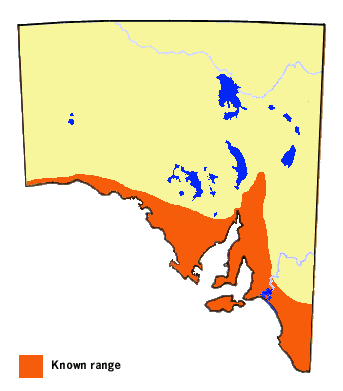
-
Habitat
-
The butterfly occurs in open temperate heathland, shrubland, woodland and forest,
having some grass in the understorey. Guaranteed autumn rain, and annual rainfall
in excess of about 300 mm is probably an ecological prerequisite. Rarely found
in dry mallee habitat, except in coastal areas. It prefers cool, damp and shady
areas where its hostplant remains in a green condition.
-
Conservation Status in South Australia
-
Locally common. In the northern parts of its range it is usually very local
but can be common in the West Coast area.
-
Threats
-
No major threats. In urban areas, the nematodes used to combat the introduced
Portuguese millipede will also kill larvae of this butterfly.
-
Conservation Strategy
-
None required.



